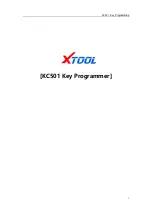
Here are a few time saving techniques to
help you on your next job:
1) Use the shortest hoses possible and
when possible avoid hoses with
schrader depressors. This will help
assure the fastest and quickest
recovery possible.
2) Know what kind of refrigerant you
are going to recover and the amount.
You need to know what kind to
avoid contamination. More
importantly you need to know how
much refrigerant you plan to
recover. This will help you avoid
overfilling your recovery cylinder
which can have disastrous results.
3) If you plan on recovering large
amounts of refrigerant (20lbs or
more) it would be a good idea to use
the push-pull method
. Note: This
process requires you to switch
hoses to finish recovering the
remaining vapor. See the “Push–
Pull Liquid Recovery” section of
this manual.
4) Protect your RecoverX by using an
in-line filter drier. Failure to use a
suction filter drier can cause damage
to your compressor.
5) Recovery machines are not vacuum
pumps. For proper evacuation use
your YELLOW JACKET vacuum
pump. To speed up the evacuation
process try using your TITAN™
manifold and core removal tool
(P/N 18975). For more information
contact your local YELLOW
JACKET wholesaler.
8
Recovery Tips and Techniques
RecoverX
Front View
5) Uncap the suction port. The compres-
sor oil will come out of the drain port.
Low pressure compressed air can be
applied to the suction port to assist the
draining process.
6) Refill the oil sump with 7 ounces of
POE refrigerant oil.
7) Return the machine to a flat position
and check the oil level as described
previously.
Compressor Maintenance, cont.
Vapor Recovery Diagram
Push-Pull Liquid Recovery
The Push-Pull Liquid Recovery method is
used for transferring large volumes of
liquid refrigerant. The RecoverX “pulls”
vapor from the recovery cylinder and
produces high pressure discharge gas that
“pushes” liquid out of a HVAC system
into a recovery cylinder (see page 6 for
diagram).
Some systems may not allow push-pull
liquid recovery.
If any of the following
conditions apply to your recovery job,
proceed directly to the Vapor Recovery
Method.
•
Equipment contains less than 8 pounds
of refrigerant.
•
Equipment is a heat pump or other unit
with a reversing valve.
•
Equipment has an accumulator be-
tween the service ports used in liquid
recovery.
•
Liquid refrigerant has migrated and the
location of the refrigerant is not
known.
•
The refrigerant system does not allow
for a solid column of liquid refrigerant
to be formed.
When using push-pull recovery, the
RecoverX will not recover to the re-
quired vacuum level in the recovered
system.
Use a sight glass to determine
when the liquid is being “pushed” into the
recover tank. When liquid refrigerant is
no longer visible, go to the Vapor Recov-
ery section of this manual for further in-
structions.
The hose connections for push-pull liquid
recovery are shown on page 6. Perform
the following steps for push-pull liquid
recovery:
1) Ensure the recovery unit
Power
Switch
is off (
○
) and the power to the
system to be serviced is also turned
off.
2) Connect the recovery unit, the sys-
tem to be serviced, the manifold set,
and the recovery tank as shown on
page 6.
3) Open the valves on the recovery cyl-
inder.
4) Turn the
Bypass Valve
to “OPEN.”
5) Turn the
Power Switch
on (
׀
).
5
























